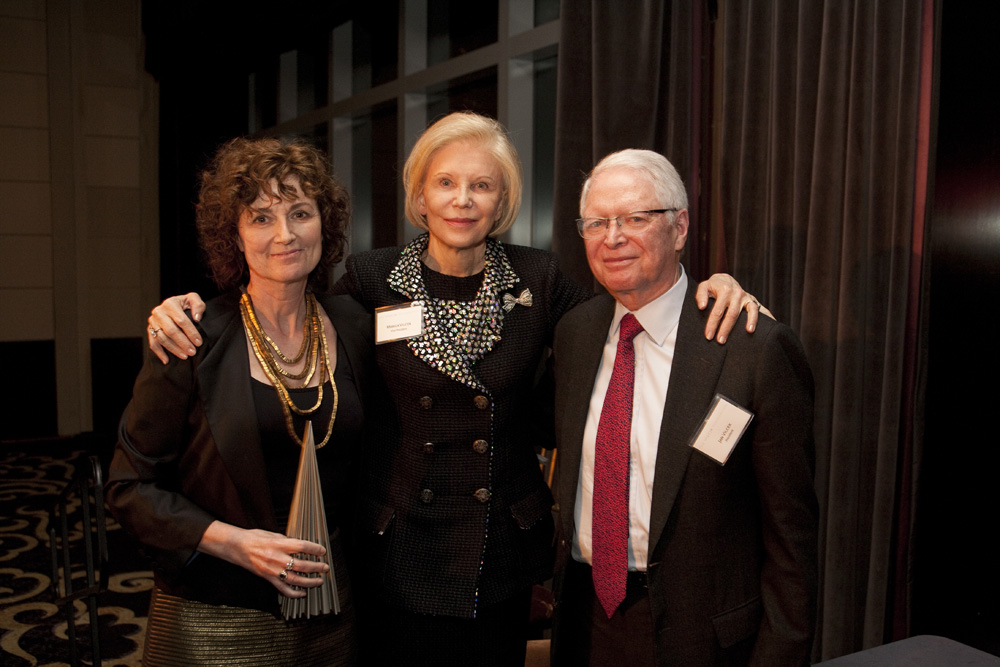
We’re pleased to welcome to Dr. Titia de Lange to the Vilcek Foundation’s board of directors! She will be taking the place of Dr. Joan Massagué, who is stepping down after six years of dedicated service. Peter Lugwig, currently an honorary director, will resume a position on the board as well; he will be replacing Mr. Richard Gaddes, who also leaves us after six years of distinguished service.
We first met Titia when she received the Vilcek Prize for Biomedical Science in 2011. Then, she was being recognized for her groundbreaking work on telomeres, the protective elements at the ends of chromosomes that are essential for the maintenance of genetic integrity. She has studied telomeres since she was a postdoctoral fellow in the laboratory of Nobel Laureate Dr. Harold Varmus, at the University of California, San Francisco, where she was among the first to isolate the telomeres of human chromosomes.
 Titia de Lange, with Marica Vilcek and Jan Vilcek, at the 2011 Vilcek Prizes gala.
Titia de Lange, with Marica Vilcek and Jan Vilcek, at the 2011 Vilcek Prizes gala.
Her time in the lab of Dr. Varmus was formative in more ways than one: Originally, Titia planned to return to her native Amsterdam once she completed her post-doctoral research. Titia had already completed her doctorate in biochemistry from the University of Amsterdam and the Netherlands Cancer Institute in 1985. However, she decided to pursue her research in the U.S. partly because of how much better women were represented in the sciences, compared to Holland. “At the time,” she says, “women were expected to be homemakers; at best women pursued professions as a hobby.”
With her singular accomplishments in hand, Titia was offered a position at the Rockefeller University in New York soon after completing her studies in San Francisco; today, Titia is the Leon Hess Professor, Director of the Anderson Center for Cancer Research, and head of the laboratory for Cell Biology and Genetics.
Her laboratory is known for its identification of shelterin, the protein complex that binds to telomeres and prevents DNA damage signaling and inappropriate DNA damage repair at chromosome ends. When shelterin is compromised, cells perceive their chromosome ends as if they are DNA breaks, resulting in cell cycle arrest. Dr. de Lange’s group discovered that shelterin protects chromosome ends by remodeling telomeres into a looped structure, the t-loop, that hides the chromosome end. Deficiency in telomere function can cause genomic alterations in cancer, and mutations in telomere components have been linked to a variety of diseases including aplastic anemia and pulmonary fibrosis.
Although her main interest in research remains telomeres, Titia’s lab also studies how cells detect and repair DNA damage, by the way of dysfunctional telomeres. “When telomeres lose their protective function, they are processed by DNA repair pathways and activate the DNA damage response,” she explains. “We found that dysfunctional telomeres are a very good way to study these pathways and have learned some things that would have been hard to figure out without the help of dysfunctional telomeres.”
For her important body of research, Titia has won many awards and honors, such as the 2014 Gairdner International Award and the 2013 Breakthrough Prizes in Life Sciences. True to her international roots, she is a member of the Royal Dutch Academy of Sciences, the European Molecular Biology Organization, the American Academy of Arts and Sciences, and is a foreign associate of the National Academy of Sciences.
Overall, though, Titia is a true New Yorker: Outside of the lab, she enjoys hiking, art, theater, and “most of all, Manhattan.”